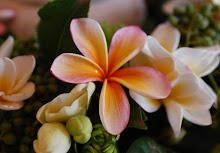
Science tells us that the sense of smell is somehow linked to memory and emotions because it is processed in the same part of the brain. Aromas trigger associations - suggesting, exiting, disturbing, etc, and our reactions to scents can be quite personal.
Up until the 1920's, single flower essences were most common in commercial perfumes. Blends were just becoming possible and extraction methods and "fixing" of fragrances were being developed.
It has been said that a perfumer, using natural talents and very high skills, blends selected ingredients much as a composer combines instruments of an orchestra and most perfumes today are complex blends of ingredients, including synthetic equivalent as a foundation.
In 1991, a team of Japanese researchers collected almost 500g ( 1 pound) of flowers from each of the two frangipani varieties - the common white/yellow "Celadine" and dark red variety "Irma Bryan". They subjected flowers to steam distillation and produced a miniscule 70 milligrams ( 0.002 ounces) of frangipani essential oil. This oil was then further subjected to tests by spectrometry and chromatography that reveal that each cultivar had it's unique oil composition, white/yellow "Celadine" being very different to that of the red "Irma Bryan".
Naturally, making frangipani perfume using traditional techniques of extractions makes very expensive product - this is reflected in the pricing and the best is sold as "frangipani absolute".
Not long ago I remember reading about a survey of available perfumes worldwide - interestingly, only a couple of them contain pure frangipani oil. "Coco" by Chanel contains frangipani in it's ingredients and "Narcisse" by Chloe have Plumera rubra as it's dominant note.
For many people, frangipani flower fragrance is the most important feature and the plant itself sealed the popularity of frangipani's forever.
PS - spotted this beauty the other day on my early morning walk - her scent was strong honeysuckle - heaven!

























fascinating post! thank you for that...
ReplyDeleteAn interesting post about frangipani and great information on their scents. You have a lovely collection of different types of frangipani and they are absolutely gorgeous!
ReplyDeleteI have this red one flowering right now. Beautiful!
ReplyDeleteThis has been a very significant blog indeed. I’ve acquired a lot of helpful information from your article. Thank you for sharing such relevant topic with us.
ReplyDeletecall Pakistan
Great post! I love all the varieties. And they're just starting to leaf here in SE Florida!
ReplyDeleteBTW, I wanted to let you know that I'm giving you a blogger award. I've posted about it in my latest post, "A Gift", and linked to your blog. I hope you'll accept...I think you definitely deserve it!